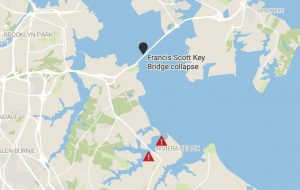
Key Bridge collapse could be largest-ever financial maritime loss
The deadly collapse of Baltimore’s Francis Scott Key Bridge could rival or beat the maritime industry’s largest-ever financial loss, with insurance claims expected to reach $1 billion or more.
“It’s going to be a big claim, and the big number there is the potential cost to rebuild the bridge,” said John A. Miklus, president of the American Institute of Marine Underwriters, in an interview Tuesday, a week after the bridge was struck by the freighter Dali and collapsed, killing six people. “This is one of the largest, most complicated marine claims I can think of.”
The cost of rebuilding the nearly 50-year-old steel arch bridge alone could run high into the hundreds of millions of dollars. Miklus and other experts believe the bridge collapse, which sent a crew of workers who were repairing potholes on Interstate 695 tumbling into the frigid Patapsco River, could rival the largest financial loss to date.
That occurred over a decade ago, when 33 people died after the Italian cruise ship Costa Concordia grounded off the coast of Italy and partially sank during a Mediterranean voyage. The International Group of P&I Clubs, a group of 12 self-insurance clubs that offer marine liability coverage for 90% of the world’s oceangoing vessels, paid $1.5 billion in claims.
Britannia, a P&I member that collectively shares loss exposures among the 12, insures Dali owner Grace Ocean Private Ltd., according to Britannia’s website. Britannia and the other clubs are backed by an extensive reinsurance pool that spreads losses throughout the global insurance market, made up of large, well-capitalized companies with a maximum claims capability of $3.1 billion.
“They’re the ones that are going to be on the hook for the big numbers, because that encompasses all of those third-party liabilities … removal of the debris, loss of life, rebuilding the bridge,” Miklus said.
On Monday, Grace Ocean took the expected first step in what likely will lead to years of litigation to sort out who pays for which damages and how much.
Singapore-based Grace Ocean and Synergy Marine Pte. Ltd., which manages the 984-foot cargo ship, together filed a claim in Baltimore’s U.S. District Court asking a judge to clear them from liability or limit damages to the value of the ship plus the revenue it stood to make from its cargo, which they estimated at $43.7 million.
For more than a century, vessel owners that do business in the U.S. have routinely filed such petitions when faced with catastrophes that cause death, injuries and damage. They’ve been entitled to do so since 1851, when the Limitation of Liability Act — similar to international convention — was passed to protect the nascent U.S. shipping industry from claims for such incidents out of owners’ control such as piracy or storms. The law allows vessel owners to limit liability to the value of the ship and its freight bill.
In today’s market, experts said, the law prevents high damage payouts from crushing maritime companies and in turn crippling the nation’s ability to maintain a commercial fleet.
Shortly after leaving the Port of Baltimore for a monthlong voyage to Sri Lanka, the Dali experienced a reported power outage near Key Bridge and smashed into one of its principal supporting piers around 1:30 a.m. March 26. The bridge crumbled in an instant, blocking the only channel into the port with twisted wreckage.
Authorities rescued two of the men quickly but have recovered only the bodies of two others, with four members of the road crew presumed dead.
The debris and efforts to recover the bodies have shut down vessel passage into and out of the Port of Baltimore.
In an order Monday, U.S. District Judge James K. Bredar said anyone with a claim against the companies that own and manage the Dali must file it with the clerk’s office at the federal courthouse in Baltimore, and serve the companies’ lawyers, by Sept. 24. Britannia will establish a $43.7 million security fund with the court.
Probably the most well-known case in which a vessel owner was absolved of liability concluded in 1916, four years after the Titanic sank on its maiden voyage across the Atlantic. Despite hundreds of claims seeking more than $16 million in damages, out-of-court negotiations led to a settlement of $664,000.
“In exchange for their funds, claimants agreed to end their claims in the United States and England, and acknowledge that the [owner] White Star Line “had no ‘privity or knowledge’ of any negligence on the Titanic,” according to a Library of Congress blog.
That “privity or knowledge” standard is one the courts still use to determine liability. In the case of the Dali, the judge will need to determine whether ship owners were at fault.
Although liability limitation petitions are regularly filed in cases of maritime casualties, so ship owners can consolidate claims before a judge, only 32% of petitions succeed in limiting a ship owner’s liability, according to research completed several years ago by Elena Mihos, a master’s student at Tulane University Law School, supervised by Martin Davies, director of Tulane Maritime Law Center.
“It’s relatively easy for claimants to find a way of establishing unlimited liability,” Davies said in an interview. “What the liability claimants will have to show is some fault on the part of the ship owner itself.
“I do think it’s fairly unlikely that the ship owner will be able to limit its liability in the present case,” he said. “In your typical limitation suit, what happens is the claimant will make some claim that there’s some defect in the ship itself. If they can show that, then the ship owner is going to be responsible for the condition of the vessel, and then it will not be able to limit its liability.”
The vessel could be responsible for “third party” liabilities, such as the death of the bridge workers, removal of debris, and the cost to rebuild the bridge. Other liabilities could be related to loss of business or work due to the shutdown of the port, Miklus said.
“There could be other aspects of liability, and they’re all bound to make claims for lost business,” Miklus said. “Whether they’re successful or not, I don’t know, but I’m sure they’ll try.”
He said separate policies cover cargo and the vessel itself, which before the crash was valued at $90 million, according to Grace Ocean’s filing. In some cases, cargo insurance helps to cover salvage costs.
In an email Monday, Jennifer Donelan, a spokeswoman for the Office of Maryland Attorney General Anthony Brown, said the office is working with Gov. Wes Moore’s administration and state agencies “to protect and defend the interests of the State from the harms caused by the collapse of the Francis Scott Key Bridge.”
“The Attorney General will represent the State in any litigation, including actions to hold accountable the parties responsible for this disaster,” Donelan said.
Related Articles
What is a ship pilot? In Baltimore’s Key Bridge crash, an experienced one appeared to delay disaster.
Map: View where debris from the Key Bridge collapse has been reported
How will the Baltimore bridge collapse impact Massachusetts: ‘Boston could certainly take more ships and cargo’
Key Bridge collapse minute-by-minute: Recordings, reports fill in timeline of Baltimore disaster
Key Bridge investigation: NTSB analyzes ship’s onboard data for clues about collision
But only claims such as those involving personal injury, death, physical damage to property, such as loss of the bridge, will likely move forward, Davies said.
“That’s all that maritime law will allow,” he said, because of limitations established by a U.S. Supreme Court decision known Robins Dry Dock.
Under that precedent, losses can be recovered only for personal injury, loss of life or physical damage to property.
“All sorts of people will suffer economic losses as a result of this, but none of those claims can succeed as a matter of maritime law,” Davies said. “I imagine many, many people will file claims, but the Robins Dry Dock rule is pretty clearly in favor of the ship here.”
Litigation is expected to drag out as costs of bridge rebuilding and other efforts are worked out.
John Woods, a maritime attorney and partner at Clyde & Co. in New York, which specializes in international trade, transportation and insurance, believes the ship owner may be able to limit liability under law based on facts made public to date.
“There aren’t facts yet out that would indicate the ship owner knew or should have known of whatever condition it was that caused the blackout on the ship and for the ship to lose steering and propulsion,” he said. But, “that all remains to be seen and will come out in the investigation.”
“I’d say that this is the first salvo in what will be a protracted legal battle as to who pays for this casualty,” he said.
Baltimore Sun reporter Alex Mann contributed to this article.


